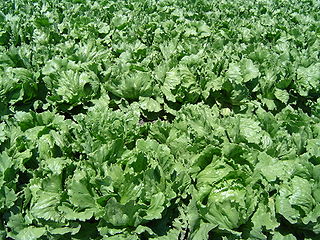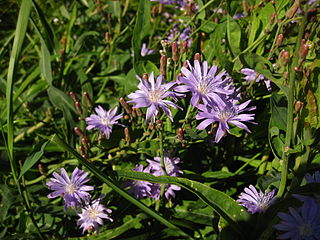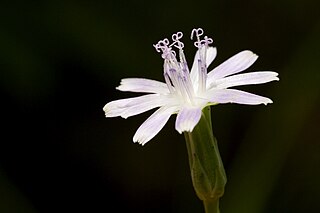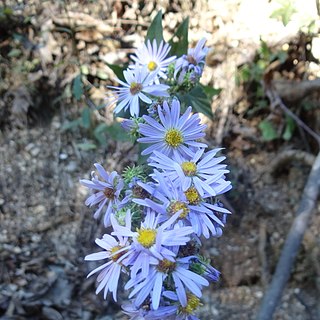
Lettuce is an annual plant of the family Asteraceae. It is most often grown as a leaf vegetable, but sometimes for its stem and seeds. Lettuce is most often used for salads, although it is also seen in other kinds of food, such as soups, sandwiches and wraps; it can also be grilled. One variety, celtuce, is grown for its stems, which are eaten either raw or cooked. In addition to its main use as a leafy green, it has also gathered religious and medicinal significance over centuries of human consumption. Europe and North America originally dominated the market for lettuce, but by the late 20th century the consumption of lettuce had spread throughout the world. As of 2021, world production of lettuce and chicory was 27 million tonnes, 53 percent of which came from China.

Hepatica is a genus of herbaceous perennials in the buttercup family, native to central and northern Europe, Asia and eastern North America. Some botanists include Hepatica within a wider interpretation of Anemone.

Lactuca, commonly known as lettuce, is a genus of flowering plants in the family Asteraceae. The genus includes at least 50 species, distributed worldwide, but mainly in temperate Eurasia.

Lactuca virosa is a plant in the Lactuca (lettuce) genus, often ingested for its mild analgesic and sedative effects. It is related to common lettuce, and is often called wild lettuce, bitter lettuce, laitue vireuse, opium lettuce, poisonous lettuce, tall lettuce, great lettuce or rakutu-karyumu-so.

Tiarella, the foamflowers, is a genus of flowering plants in the family Saxifragaceae. The generic name Tiarella means "little turban", which suggests the shape of the seed capsules. Worldwide there are seven species, one each in eastern Asia and western North America, plus five species in eastern North America. As of October 2022, the taxonomy of Tiarella in eastern North America is in flux.

Lactuca serriola, also called prickly lettuce, milk thistle, compass plant, and scarole, is an annual or biennial plant in the tribe Cichorieae within the family Asteraceae. It has a slightly fetid odor and is commonly considered a weed of orchards, roadsides and field crops. It is the closest wild relative of cultivated lettuce.

Symphyotrichum ericoides, known as white heath aster, frost aster, or heath aster, is a species of flowering plant in the family Asteraceae native to much of central and eastern North America. It has been introduced to parts of Europe and western Asia.

Anemone hepatica, the common hepatica, liverwort, kidneywort, or pennywort, is a species of flowering plant in the buttercup family Ranunculaceae, native to woodland in temperate regions of the Northern Hemisphere. This herbaceous perennial grows from a rhizome.
Calyptridium pulchellum, synonym Cistanthe pulchella, is a rare species of flowering plant in the family Montiaceae. It is known by the common name Mariposa pussypaws. It is endemic to the Sierra Nevada foothills of central California, where it is known from only a few scattered occurrences. It grows on barren patches of granite gravel in woodland and grasslands. It is a federally listed threatened species.

Symphyotrichum pilosum is a perennial, herbaceous, flowering plant in the Asteraceae family native to central and eastern North America. It is commonly called hairy white oldfield aster, frost aster, white heath aster, heath aster, hairy aster, common old field aster, old field aster, or steelweed. It may reach 20 to 120 centimeters tall, and its flowers have white ray florets and yellow disk florets.

Symphyotrichum falcatum is a species of flowering plant in the family Asteraceae. Commonly called white prairie aster and western heath aster, it is native to a widespread area of central and western North America.

Lactuca tatarica, known as blue lettuce, is a Eurasian flowering plant in the tribe Cichorieae within the family Asteraceae. It is widespread across much of Europe and Asia.

Symphyotrichum oolentangiense, commonly known as skyblue aster and azure aster, is a species of flowering plant in the family Asteraceae native to eastern North America.
Blue lettuce, wild blue lettuce, or common blue lettuce can refer to:

Lactuca graminifolia, the grassleaf lettuce is a North American species of wild lettuce. It grows in Mexico, Central America, Hispaniola, and the southern United States from Arizona to Florida, Virginia and the Carolinas.

Symphyotrichum patens, commonly known as late purple aster or spreading aster, is a perennial, herbaceous plant found in the eastern United States.
Lactuca raddeana is a species of wild lettuce native to Vietnam, eastern China, the Korean peninsula, the Russian Far East, Sakhalin, the Kuril Islands, and Japan. A biennial or perennial, growing to 2 m, it has a very wide range of variation in leaf shape, across a spectrum from undivided leaves to pinnatipartite leaves. It is edible but bitter.
Lactuca watsoniana, locally known as alfacinha, is a species of wild lettuce endemic to the Azores. An endangered species, there are fewer than 2000 individuals remaining in the wild. DNA evidence shows that it is closely related to the North American species of Lactuca, while the Canary Islands endemic Lactuca palmensis is more closely related to African and European Lactuca lineage.
Lactuca dolichophylla, the long-leaved lettuce, is a species of wild lettuce found in Afghanistan, Pakistan, West Himalaya, Nepal, Xizang (Tibet), East Himalaya, south-central China, and Myanmar. It prefers to grow in thickets at c.3200 m above sea level. Its chromosome count is 2n=16.

Symphyotrichum anomalum is a species of flowering plant in the family Asteraceae native to Arkansas, Illinois, Kansas, Missouri, and Oklahoma. Commonly known as manyray aster, it is a perennial, herbaceous plant that may reach 20 to 120 centimeters tall. Its flowers have lavender or blue to purple, seldom white, ray florets and cream or light yellow, then pinkish-purple disk florets. Its flowers are attractive to butterflies. The lower leaves have untoothed margins and are heart-shaped at the base.














